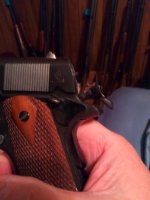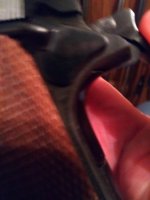He hn
Some of the responses here are….sketchy.
I was issued a 1911 in the military, I concealed carried one as an off duty weapon when I was an LEO and while it is no longer my go to concealed carry weapon I conceal carried a 1911 for a couple decades, and still carry it when the mood strikes.
Here’s my take on it given 38 years of experience with it:
1) The hammer can be decocked with one hand by placing your thing over the front face of the hammer and pressing it back to depress the grip safety.
That isn’t accidental, it’s an intentional design element. There was simply no other reason to use the grip safety as the tang on the 1911.
The question is whether it was ever intended to be done with one hand or two. It does take some practice to do it one handed and to do it safely. Even with two hands, you want to press the hammer all the way back against the tang to lift the hammer’s sear notch off the sear to ensure you have it under positive control before you pull the trigger.
2) Just like on the John Browning designed Winchester Model 1892 and 1894 rifles and carbines, the quarter cock notch is there to catch the hammer and prevent it from striking the firing pin of the hammer slips while you are manually cocking it.
IT IS NOT THERE AS ANY KIND OF DROP SAFETY. In fact, just the opposite. With the hammer down, the inertial firing pin prevents the gun from going off if dropped.
There is an exception to this. When I was an LEO I read about drop testing the Series 70 1911 (a few years after the series 80 came out). The conclusion was you could get a Series 70 1911 to fore Whn dropped, but it had to be dropped muzzle down at a near vertical angle from at least 3’ onto a concrete floor. Of course under those circumstances the round would just put a divot in the concrete with minimal risk to anyone.
In contrast, if you carry it with the hammer on the quarter cock position, a blow to the back of the hammer can both shear the quarter cock notch, and impart enough energy to the firing pin to cause the weapon to fire. My dad had a Model 1892 slip on a tractor with the hammer striking the axel on the way down. The carbine fired and shot him under his ribs and exiting out the back near the top of the shoulder blade.
Do not leave a hammer on the quarter cock notch, unless it also has a firing pin safety.
3). The consensus of expert opinion over the last 100 years has been that Condition 1 (cocked and locked on a loaded chamber) carry makes the most sense for law enforcement and armed citizen use. It’s safe, it’s fast and it’s consistent as you just have to learn to place your thumb over the thumb safety as you draw and depress it when the muzzle is pointed down range.
If you carry it in Condition 2 (hammer down on a loaded chamber). You will have to manually cock the hammer to ready the pistol for action. That’s a fiddly fine motor activity that you will suck at under extreme stress and time pressure. It’s one of the big reasons why the quarter cock notch is there.
Condition 3 carry (hammer down on an empty chamber). Makes sense for the military as soldiers usually have ample warning of an impending personnel threat where they might need to use their 1911 and they have time to rack the slide to chamber a round.
Soldiers armed with a 1911 were often rear area support troops who were also often poorly trained in its use, and had very little proficiency or recency. Condition 3 made sense to prevent accidents.
The Israelis used Condition 3 for all of their troops, but they did that because it was a manual of arms that worked for all of the wide variety of pistols they had in their inventory. Those included but were not limited to 1911s, Hi Powers, Walther P-38s, M1951 Berettas, and the later DA Jericho 941 and Sig P226, as well as the striker fired Glock 17 and Glock 19.
The advantage of Condition 3 over Condition 2 in a stressful situation is that racking the slide is a gross motor movement you can still perform under extreme stress. And if you practice properly sling shotting the slide it can be done very quickly.
——
As for pinning the grip safety, it was a popular thing to do back in the day for tactical pistol match shooters with big fleshy hands that didn’t always adequately depress the grip safety.
Back then most 1911s had an arched mainspring housing and a low profile grip safety which made the grip safety more likely to not be fully depressed.
That arched mainspring housing was a change on the 1911A1. The original 1911 had a flat mainspring housing. Today virtually all 1911s being sold have a flat mainspring housing as well as a higher profile grip safety or a grip safety with a hump on it.
Original 1911:
The 1911 at 12 o’clock is a 1991 series Colt Government model with a retro flat mainspring housing but it still has a higher profile safety lever.
The other two demonstrate the two different approaches to increasing the profile.
The end result is virtually no one pins a grip safety anymore. It’s just not needed.
There are benefits to having it.
If you are reholstering a 1911 after using it in a real world combat or self defense situation, the action of lifting and pivoting the pistol to put it back in the holster usually lifts the hand off the grip safety.
If you are properly trained to intentionally put your thumb between the hammer and slide, without pressing back on the hammer, or alternatively to press forward on the tang or beaver tail, your hand is completely off the grip safety.
Either way with your hand off the grip safety it still won’t fire even if you are under extreme stress and both:
- forget to engage the manual safety; and
- forget to take your finger off the trigger when you try to shove the pistol back in the holster.
Compare that to what happens when an excited officers tries to reholster a Glock with his finger still on the trigger. There’s a reason modern duty holsters designed for striker fired pistols are so far out away from the leg.
——
The reality is that most negligent discharges in the home occur during administrative handling of a pistol. People come home, and decide it’s safer to unload it before putting it somewhere like on top of the refrigerator to keep it safe from the kids.
That means handling the pistol to un load it and then reload it, and none of it is necessary. Just leave the gun on u to, you go to bed and then put it in a decent lock box or biometric hand gun safe and leave the gun loaded. And if it’s a 1911, leave it in Condition 1.






